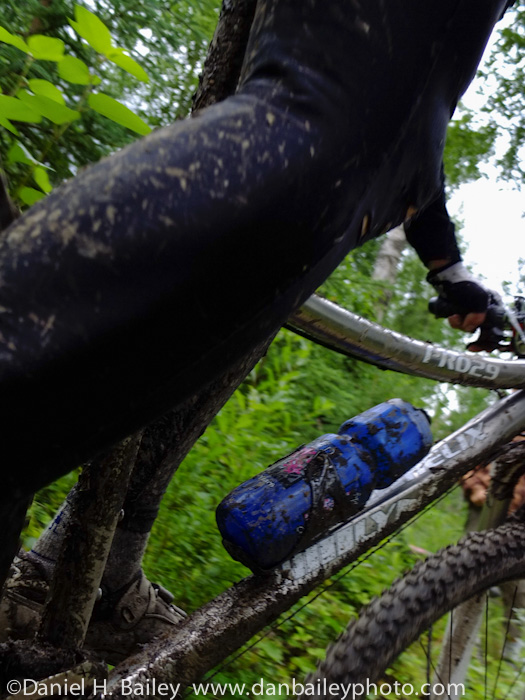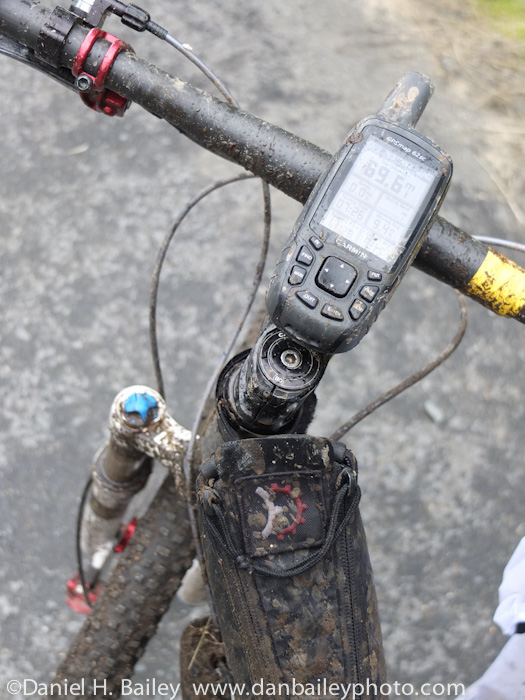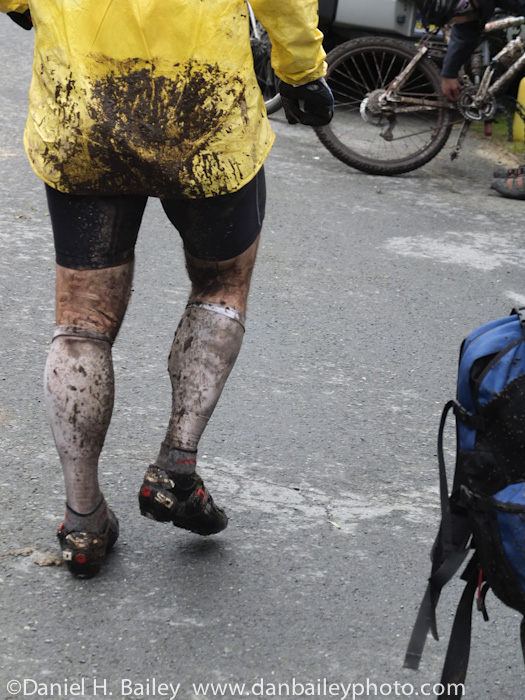 This weekend I ran support for my wife during her ride on the Soggy Bottom 100, a grueling 100-mile mountain bike race on the Kenai Peninsula here in Alaska. I was hoping to race myself, or at least ghost ride with her during last leg, but with a cracked rib that I gave myself by riding way too fast across a wet bridge a few days earlier, I opted out on the 10,000′ of climbing and descending on mud and rocks.
This weekend I ran support for my wife during her ride on the Soggy Bottom 100, a grueling 100-mile mountain bike race on the Kenai Peninsula here in Alaska. I was hoping to race myself, or at least ghost ride with her during last leg, but with a cracked rib that I gave myself by riding way too fast across a wet bridge a few days earlier, I opted out on the 10,000′ of climbing and descending on mud and rocks.
 Instead, I spent Saturday hanging around the checkpoints and taking pictures for fun with my Fuji X10. Up until now, I hadn’t shot a ton of action sports with the X10, so Saturday gave me a chance to see what it can really do.
Instead, I spent Saturday hanging around the checkpoints and taking pictures for fun with my Fuji X10. Up until now, I hadn’t shot a ton of action sports with the X10, so Saturday gave me a chance to see what it can really do.
As I’ve said in previous posts, the X10 in an incredibly capable little camera. The autofocus system is quite fast, and although it’s not perfect, I’ve been learning a few tricks that can help maximize its performance.
Prefocusing works great, especially when you have an idea of the distances that you’ll be working with. For this shot, I was just holding the camera as close to the bikers as I could as they raced by, which is something I do all the time with my big cameras. With the X10 on Shutter Priority mode at 1/1000 sec shutter speed, I set the focus before each rider came by. It wasn’t exact, but since it’s already close, it doesn’t have to waste time running through the entire focus range looking for subject matter; it locks onto the bike pretty quickly.
Another thing that makes a huge difference, whether you’re shooting action or not, is to just keep the camera on continuous shooting mode. This lets you keep firing and capturing minute differences in action, expression and subject placement in the frame without having to stop and let the camera write to the memory card.
With it’s fast write time CMOS sensor, the Fujifilm X10 fires at 7 fps at full resolution, and 10 fps at medium resolution, so it’s more than fast enough to capture entire sequences at shooting speeds that rival most DSLRs. I don’t have a battery grip, so 7 fps is faster than my D700.

However, let us not forget that the technical details and specifications of a camera, whether it’s a full on DSLR or a compact camera that fits in your pocket, are only tools that play a part in the telling of the story.
Ultimately, the feel, emotion and narrative of your imagery is what matters, regardless of what camera you used to make it.
What excites me so much these days is that the technical performance of today’s compact cameras like the X10 are good enough that they fit in nearly seamlessly with my shooting style.
I keep finding that for the features that it has, including the zoom, macros and full manual controls, the X10 gives me just about everything I need to tell the story of my visual fascination with the world, even when I want to go completely unencumbered.
In the past, I have always resigned myself that I’d be carrying 10-15 extra pounds of metal, glass and electronics no matter where I went in life for the rest of my life. Happily, this is no longer true. Don’t get me wrong, I still LOVE my big Nikons and won’t give them up anytime soon, I don’t have to carry them everywhere anymore.

As I keep learning the little tricks that help make cameras like the X10 even more usable for shooting action and adventure sports, I’m sure that I’ll be leaving the big cameras behind even more.
And it’s not like the X10 is the only high performance compact camera out there, it’s just my own personal favorite. The Nikon J1 also has incredibly fast autofocus, and the Panasonic Lumix LX5 has RAW capability, great macro and Leica glass.
More than ever before, compact cameras are seriously worth looking into, even if you’ve already got lots of big cameras.
If you missed my post last week, right now the Fujifilm X10 is on sale at B&H photo.
[iframe]<iframe width=”120″ scrolling=”no” height=”150″ frameborder=”0″ style=”border:none;” border=”0″ padding=”5″ src=”http://mer54715.datafeedfile.com/widget/aff_widget_prdt_generate-2.0.php?aff_num=6746&aff_net=1&widget_num=749″ marginheight=”0″ marginwidth=”0″></iframe>[/iframe]
